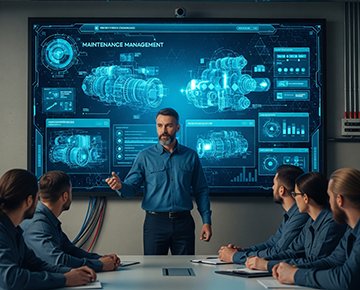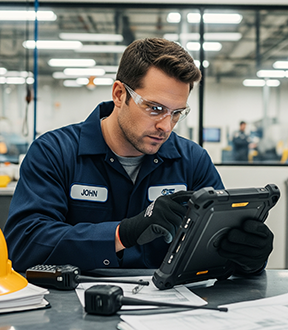Published: September 30, 2025 | Updated: September 26, 2025
Published: September 30, 2025 | Updated: September 26, 2025
Building a High-Performing Maintenance Team: Essential Skills and Technology
 The effectiveness of any organization’s physical assets rests squarely on the shoulders of its maintenance team. This group of individuals must navigate complex equipment, demanding schedules, and unexpected failures. Building a high-performing maintenance team requires more than just technical aptitude; it demands a focus on the essential interpersonal skills that make collaboration work. When members operate as a unified force, they achieve a level of collective success that individual effort simply cannot match.
The effectiveness of any organization’s physical assets rests squarely on the shoulders of its maintenance team. This group of individuals must navigate complex equipment, demanding schedules, and unexpected failures. Building a high-performing maintenance team requires more than just technical aptitude; it demands a focus on the essential interpersonal skills that make collaboration work. When members operate as a unified force, they achieve a level of collective success that individual effort simply cannot match.
Clear Communication: The Foundation of Maintenance Teamwork
Communication is the bedrock of any successful group effort. In maintenance departments, clear and direct communication prevents confusion, reduces downtime, and ensures safety. Team members must convey information accurately, whether they are reporting an equipment failure, handing off a project to the next shift, or coordinating with outside contractors. A single miscommunication about a part number or a lockout procedure can create significant hazards or delays.
For example, in a large-scale manufacturing plant, a technician identifies a failing bearing on a critical production line motor. They must relay this information precisely to their supervisor and the next shift's crew, specifying the machine number, the part needed, and the urgency of the repair.
CMMS as a Communication Hub
A Computerized Maintenance Management System (CMMS) elevates communication from verbal messages to a documented, searchable record. Technicians use a CMMS to log work requests, detail task progress, and attach photos or schematics. This system acts as a central hub where every team member can view the status of all current and historical work.
When the first technician logs the failing bearing in the CMMS, the system automatically notifies the supervisor. The next shift’s technician can pull up the work order on a mobile device, see the full repair history for that motor, and arrive at the job site with all the necessary information and tools. This eliminates the need for frantic phone calls or handwritten notes, establishing a single source of truth for all maintenance activities. A CMMS also provides a platform for technicians to add notes or comments to a work order, sharing institutional knowledge and valuable insights that future crews can reference. This feature becomes particularly useful for troubleshooting recurring issues.
Aligning Maintenance Teamwork with Facility-Wide Goals
A team performs at its best when every member understands and shares a common goal. This shared vision moves a group from a collection of individuals completing separate tasks to a collective working toward a single objective. In maintenance, this objective goes beyond simply fixing broken things. A high-performing team focuses on keeping assets in peak operating condition, extending equipment life, and minimizing unplanned downtime. They see their work not as isolated jobs, but as contributions to the overall health and productivity of the entire operation.
Consider a team responsible for a fleet of delivery trucks. Each technician’s work on a single vehicle contributes to the fleet’s overall reliability, directly impacting the company’s ability to meet delivery promises. A technician performing a routine oil change on one truck knows their work helps prevent engine failure for the entire fleet, contributing to the larger business goal.
Aligning Individual Tasks with Collective Goals
A CMMS provides a powerful way to make this shared vision tangible. The system lets managers create planned maintenance schedules and assign tasks that directly align with overarching business goals, like improving equipment uptime or reducing maintenance costs. Team members can view dashboards that show key performance indicators (KPIs), such as Mean Time Between Failures (MTBF) or work order completion rates. This allows everyone to see how their individual contributions impact the group’s performance metrics.
For the delivery truck fleet, the CMMS can display a dashboard showing the fleet’s total vehicle uptime. When a technician marks a preventive maintenance task as complete, they immediately see how this action contributes to the team’s goal of maintaining fleet availability. This clear connection between task and outcome motivates the team and reinforces a culture of collective responsibility.
Collaborative Problem-Solving in Facility Maintenance
The maintenance world is inherently unpredictable. Equipment fails in unexpected ways, parts shipments get delayed, and new technologies introduce unknown variables. A truly effective team possesses the ability to solve problems collaboratively and adapt quickly to changing circumstances. Instead of one person struggling alone with a complex issue, team members pool their knowledge, discuss potential solutions, and arrive at a consensus on the best course of action.
In a large hospital, for instance, an HVAC system for an operating room suddenly malfunctions. This is a high-stakes problem that requires a swift solution. The primary technician, a generalist, cannot solve the issue alone. They bring in a specialist for the control system and another technician who understands the air-handling unit’s mechanical components. Together, they diagnose a unique electrical issue that no one person could have found on their own.
Using CMMS Reports to Improve Maintenance Team Decisions
A CMMS provides the data and history needed for effective problem-solving. It stores an asset’s entire maintenance history, including past work orders, inspection reports, and technician notes. This historical data offers valuable clues for diagnosing new problems. When the hospital’s maintenance crew faces the HVAC issue, they consult the CMMS. They find records of similar, though not identical, electrical issues from two years prior. This information helps them identify the probable cause much faster.
Furthermore, the CMMS's reporting capabilities give managers the information they need to predict potential failures. By analyzing failure trends, they identify equipment that requires special attention or technician training. This informational approach allows the team to shift from reactive firefighting to proactive maintenance, preventing problems before they even occur and making the entire operation more resilient.
Discover how streamlined maintenance processes can elevate production. Learn more.
Cross-Training for Maintenance Teamwork and Facility Resilience
A highly effective maintenance team is not a static entity; it continually evolves through learning and skills development. Individual technicians grow their capabilities through training, and the team as a whole becomes more versatile through cross-training. Cross-training involves teaching team members to handle tasks outside their typical responsibilities. This makes the team more flexible and reduces the impact of staff absences or turnover.
A utility company’s electrical division, for example, might cross-train its line workers on basic hydraulic systems so they can perform minor repairs on their own vehicles without waiting for a separate vehicle maintenance crew. This simple shift in skill sets saves significant time and money.
Alt text: A supervisor discusses performance and efficiency with a maintenance technician through CMMS reports.
The Role of a CMMS in Skill Management
 A CMMS can act as a powerful tool for managing and tracking team skills. Within the system, a manager can create a skill matrix, recording each technician’s certifications, training records, and specialties. When a new work order for a complex machine comes in, the CMMS can help managers assign the task to the most qualified person or pair it with someone who needs training on that equipment. The system also tracks the completion of training modules, ensuring that all team members remain current on new technologies and safety procedures.
A CMMS can act as a powerful tool for managing and tracking team skills. Within the system, a manager can create a skill matrix, recording each technician’s certifications, training records, and specialties. When a new work order for a complex machine comes in, the CMMS can help managers assign the task to the most qualified person or pair it with someone who needs training on that equipment. The system also tracks the completion of training modules, ensuring that all team members remain current on new technologies and safety procedures.
For the utility company, the CMMS would show which line workers have completed the hydraulic systems course. When a minor hydraulic issue arises with a vehicle, the system can assign the task to a trained line worker, bypassing the vehicle shop entirely. This capability ensures that the right person handles the right job, while also documenting the team's ongoing professional development.
Sustaining Excellence Through Continuous Improvement
The goal of a maintenance team should not be a single moment of success, but a continuous journey of improvement. This requires a mindset of always seeking a better way to do things. High-performing teams regularly review their processes, analyze what went wrong, and make adjustments. This might involve a post-mortem discussion after a major equipment failure or a quarterly review of maintenance procedures to identify inefficiencies. The team asks critical questions: What could we have done differently? Did we have the right tools? What can we learn from this event? This reflective practice turns every challenge into a learning opportunity.
The Human-Technology Partnership: A Recipe for Success
The development of a high-performing maintenance team moves beyond simply hiring skilled technicians; it demands a deliberate cultivation of a collaborative culture. While individual technical skills remain vital, a team’s true strength comes from its collective ability to communicate openly, work toward a unified goal, solve problems together, and constantly grow its capabilities. Technology, particularly a CMMS, like MAPCON, plays a critical supporting role in this process, providing the infrastructure for communication, data analysis, and skills management.
In a world where operational demands grow more complex, the human element of teamwork remains the single greatest variable for a maintenance team’s enduring success. The challenge, and the reward, rests in bringing people and technology together to create a force that accomplishes great things.
FAQs
What is a CMMS and how does it help maintenance teams?
A CMMS, or Computerized Maintenance Management System, streamlines work orders, schedules, and communication to improve efficiency and reduce downtime.
How does MAPCON’s CMMS improve communication in maintenance teams?
MAPCON’s CMMS creates a central hub for work requests, progress updates, and repair history, ensuring everyone stays aligned.
Why is communication important in facility maintenance?
Clear communication prevents confusion, improves safety, and helps teams respond quickly to equipment failures.
Can CMMS software support cross-training and skills management?
Yes, CMMS software like MAPCON can track training, certifications, and skill levels to assign tasks to the right team members.
How does a CMMS contribute to better decision-making?
By storing maintenance histories and generating reports, a CMMS helps teams diagnose issues faster and plan preventive strategies.
What are the benefits of aligning maintenance goals with business objectives?
When maintenance tasks connect to larger goals like uptime and cost reduction, teams stay motivated and facilities run more efficiently.
MAPCON | 800-922-4336
MAPCON CMMS software empowers you to plan and execute PM tasks flawlessly, thanks to its wealth of features and customizable options. Want to see it for yourself? Click the button below to get your FREE 30-day trial of MAPCON!
Try It FREE!